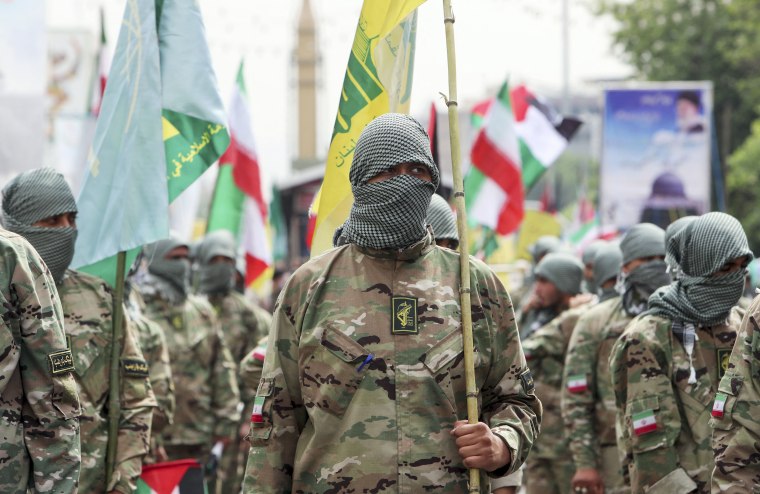Dressed in black, the group of chanting schoolgirls in the Iranian city of Shiraz appeared determined to make themselves heard.
“Basiji, go and get lost,” they shouted at a man in a gray suit standing at a podium in front of them.
NBC News has verified a video of the incident, which was posted to Twitter earlier this month, but cannot establish if the man at the podium is a member of the feared Basij militia, which has been leading the crackdown on the nationwide anti-government protests that erupted last month after the death of Mahsa Amini.
Amini, 22, from Iran’s Kurdistan region, died in a hospital three days after she was detained by police in Tehran last month and accused of failing to fully cover her hair and defying the country’s strict dress codes.
Several videos posted to social media since her death have featured demonstrators shouting angry chants against the Basij.
But who are the Basij? And what role has the organization played in the unrest in Iran that has been ongoing for almost six weeks?
Volunteer militia
Established in 1979 by the founder of the Islamic Republic, Ayatollah Ruhollah Khomeini, the Basij-e Mostaz'afin or Organization for the Mobilization of the Oppressed is a branch of the Islamic Revolutionary Guard Corps, which was designated a foreign terrorist organization by the United States in April 2019.
More commonly referred to as the Basij, which means “mobilization” in the Persian language, the militia “is an armed youth organization which for all practical purposes also serves as the ground forces of the Islamic Republic,” Ali Alfoneh, a senior fellow at the Arab Gulf States Institute in Washington, D.C., said by telephone Thursday.
The group gained prominence in the 1980s during Iran’s war with its neighbor Iraq, when waves of young, often lightly armed men, with only basic military training and without any artillery or air support, charged across open minefields.
Today, it is still comprised of volunteers and used by Iran’s government to suppress dissidents, protests, surveil the population and indoctrinate Iranian citizens, and it is also deployed during natural disasters and has a presence in government institutions, Alfoneh said.
Material benefits
Many of the militia's members come from poor, conservative backgrounds in rural Iran, or deprived districts in the country's cities and, Alfoneh said, a lot of them joined up for privileges and material benefits that come with signing up and not necessarily because of ideological reasons.
The Basij gave them access to higher education, subsidized consumer goods, free health care and job security, he added.
Signing up to the militia is also seen as respected and prestigious and allows its members to become socially mobile, said Saeid Golkar, an assistant professor at the University of Tennessee at Chattanooga who has written a book on the group.
Although there are no official figures, the group has around 1 million members, he said, although he added that “the core of the Basij is only about 100,000 active members.”
Today, the Basij enforce the country's strict religious codes, acting as morality police in public places, such as parks and at checkpoints, and heavily monitor the population, he said.
Suppression methods
There are three primary methods the Basij use to suppress anti-government protests, Golkar said.
Firstly, they patrol the streets, displaying their presence to the public, and “they create this illusion that the regime has strong social support by being on the street and facing the protesters,” he said.
Secondly, he said, members dress in plainclothes to infiltrate the protests to identify “political activists or the people who are actively chanting and mocking the regime or recording videos.”
If these methods fail, he added, the Basij will resort to force, using batons and whips to beat demonstrators and, in some cases, target them using deadly weapons, such as shotguns.
Violent history
The Basij have previously been accused of violently cracking down on individuals or groups that dare to criticize or protest against the cleric-led government.
In 2009, rights groups including Amnesty International, said the group had used excessive force during peaceful anti-government protests triggered by a disputed presidential election. Amnesty said at the time that it documented reports of the Basij beating demonstrators and firing at them with live ammunition.
Last month, the U.S. Department of the Treasury sanctioned a deputy commander of the Basij, accusing him and the militia of killing unarmed protesters on “numerous occasions.”
This followed sanctions on members of the group by Britain's treasury in January, which accused them of human rights violations, including the murder, torture and mass beatings of peaceful protesters.
Second thoughts
Despite its fearsome reputation, some members of the Basij are struggling to act against anti-government protesters, particularly young women and girls who have been leading the demonstrations, burning headscarves and furiously demanding reform from the country's leaders, Alfoneh said.
“The issue is that members are taught to have some kind of Islamic values, you know, Islamic values of honor, and now they are taught to go and beat up girls, and that of course, runs against that ethos,” he said.
